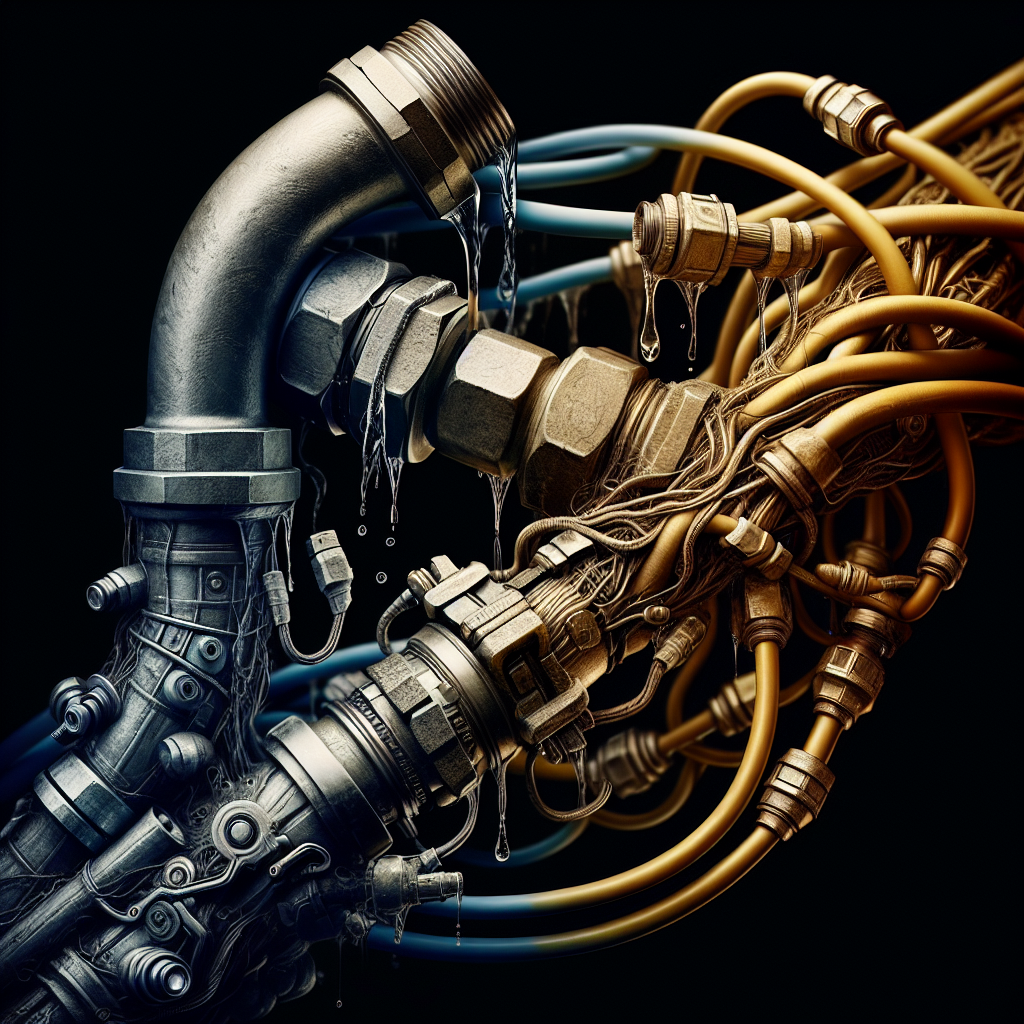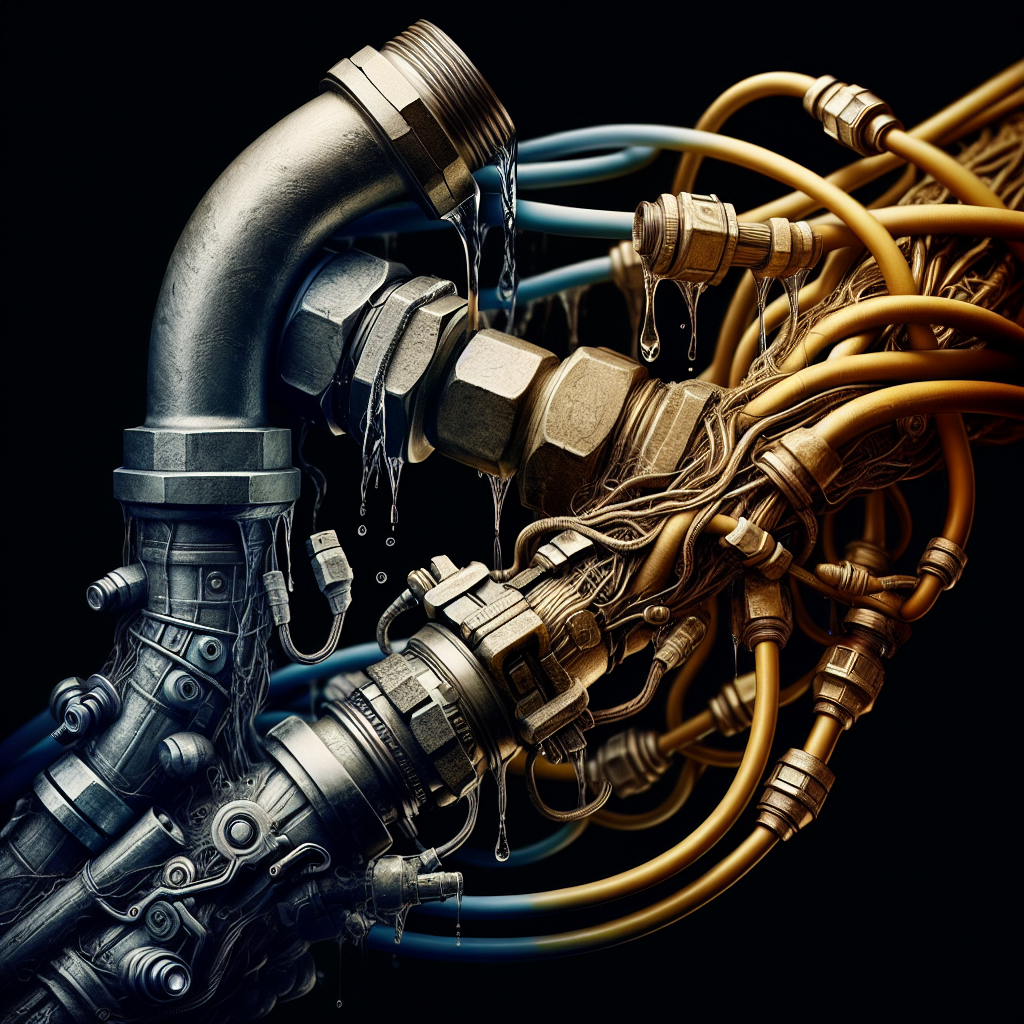Imagine your home suddenly experiences a plumbing issue, but when you call a plumber, they discover that it’s actually an electrical problem. As it turns out, the intersection of plumbing and electrical systems is more complex than we might think. From shared spaces within walls to safety regulations, these two systems often weave together in unexpected ways. In this article, we will explore the fascinating relationship between plumbing and electrical systems, gaining a greater understanding of how they converge and the importance of cooperation between plumbers and electricians. So, let’s dive into this interconnected world and unveil the intricate dance between pipes and wires!

Understanding Plumbing Systems
Plumbing systems play a crucial role in our daily lives, providing us with clean water for drinking, bathing, and other household activities. There are several types of plumbing systems commonly used in homes and buildings.
Types of Plumbing Systems
The two primary types of plumbing systems are the potable water supply system and the drainage system. The potable water supply system delivers clean and safe water for consumption and other domestic needs. On the other hand, the drainage system removes wastewater and prevents the accumulation of harmful substances.
Components of a Plumbing System
A plumbing system consists of various components that work together to ensure the smooth functioning of the system. These components include pipes, valves, fixtures, and fittings. Pipes serve as the channels through which water flows, while valves control the flow and pressure. Fixtures, such as faucets and showers, allow us to access water, and fittings connect pipes and fixtures.
Water Supply and Distribution
The water supply and distribution system is responsible for bringing water into our homes and ensuring it reaches the desired locations. Water enters the plumbing system through a main water supply line connected to a city or well water source. From there, it is distributed to different areas of the house through a network of pipes, with branches reaching individual fixtures.
Drainage and Wastewater Disposal
The drainage system is designed to remove wastewater and prevent any potential health hazards. It relies on a series of pipes that collect and transport wastewater from sinks, toilets, and other fixtures to the main sewer line or a septic tank. Adequate slope and venting are essential to ensure smooth wastewater flow and prevent the buildup of harmful gases.
Understanding Electrical Systems
Electrical systems are an essential part of our modern lives, providing us with power for lighting, heating, and operating various appliances. Understanding the different types of electrical systems and their components is crucial for ensuring their safe and efficient operation.
Types of Electrical Systems
There are primarily two types of electrical systems commonly found in residential and commercial buildings: alternating current (AC) and direct current (DC) systems. AC systems are the most prevalent, delivering electricity at high voltage through power lines. On the other hand, DC systems, typically used for small-scale applications, provide a constant and lower voltage level.
Components of an Electrical System
Just like plumbing systems, electrical systems also consist of several components that work together to provide power. These components include the main electrical panel, circuit breakers or fuses, wiring, outlets, and switches. The main electrical panel houses the circuit breakers or fuses that protect the system from overloading. Wiring distributes electricity throughout the building, while outlets and switches allow us to access power.
Power Generation and Distribution
Power generation involves the conversion of various energy sources, such as fossil fuels, nuclear, or renewable energy, into electricity. This electricity is then transmitted through power lines to substations, where it is stepped down to a lower voltage for distribution to individual buildings. From there, the electricity enters the main electrical panel, and is further distributed to different areas through wiring and outlets.
Safety Considerations
When dealing with electrical systems, safety should always be a top priority. Proper grounding and bonding are crucial to ensure the system’s safety and prevent electrical shock. Regular maintenance, such as inspecting wiring and replacing damaged components, is essential to identify and address potential hazards. It is also important to follow electrical codes and regulations to minimize the risk of accidents and ensure compliance.
Common Areas of Interaction
Plumbing and electrical systems often intersect in certain areas of a building, such as bathrooms and kitchens, where both water and electricity are used extensively. Understanding how these systems interact and the necessary precautions can help prevent accidents and ensure the smooth operation of both systems.
Shared Utility Lines
When it comes to shared utility lines, it is essential to understand how water and electrical service enter the building. Proper metering and connection points are crucial for accurate measurement and billing. Distribution panel placements should also be carefully considered to enable easy access and maintenance of electrical components.
Bathrooms and Kitchens
Bathrooms and kitchens are areas where both plumbing and electrical systems are heavily utilized. Plumbing fixtures, such as sinks, toilets, and showers, require water supply and drainage, while electrical outlets power appliances and provide lighting. Ensuring the proper installation of plumbing fixtures and electrical outlets is vital to avoid leaks, shocks, and other potential hazards.
Water Heaters and Electrical Connections
Water heaters are essential components of plumbing systems, and their proper functioning relies on electrical connections. Different types of water heaters, such as tankless, storage tank, or heat pump, have specific electrical requirements and circuits. Ensuring that these electrical connections are safely installed and meet the necessary standards is crucial for the reliable operation of the water heater.
Washer and Dryer Installations
Washer and dryer installations require both water supply connections and electrical outlets. Proper installation of water supply lines is necessary to avoid leaks and ensure efficient operation. Likewise, electrical outlets must be installed according to the specific requirements of washers and dryers. Additionally, proper grounding and bonding techniques should be employed to eliminate the risk of electrical shocks.
Preventing Interference
Interference between plumbing and electrical systems can lead to malfunctions, safety hazards, or even damage to the systems. Taking proactive measures to prevent interference is essential for maintaining the integrity and efficiency of both systems.
Avoiding Electrical Interference in Plumbing Systems
Water and electricity do not mix well, and it is crucial to prevent electrical interference in plumbing systems. When installing plumbing pipes, they should be kept at a safe distance from electrical wiring to avoid any contact. Additionally, using appropriate isolation techniques, such as pipe sleeves or electrical conduit, can further minimize the risk of interference.
Preventing Water Damage to Electrical Components
Water leaks, burst pipes, or flooding can cause significant damage to electrical components. To prevent water damage, it is crucial to promptly repair any leaks or damaged pipes. Using water-resistant or moisture-resistant materials for electrical installations in areas prone to water exposure, such as basements or bathrooms, can provide an additional layer of protection.
Proper Grounding and Isolation Techniques
Proper grounding and isolation techniques are essential to prevent shocks, fires, and other hazards in both plumbing and electrical systems. Grounding electrical components helps carry excess electrical currents safely to the ground, while isolation techniques, such as dielectric unions, prevent galvanic corrosion in plumbing systems. Following best practices and adhering to codes and regulations ensures the proper implementation of these techniques.

Codes and Regulations
Building codes and regulations serve as guidelines to ensure the safe design, installation, and operation of both plumbing and electrical systems. National and local codes define the specific requirements and standards that must be followed during construction or renovation projects.
National and Local Building Codes
National building codes provide a set of standards applicable across the country, serving as a baseline for construction practices. However, local building codes may include additional requirements specific to the region, considering factors such as local climate, seismic activity, or environmental considerations. Adhering to both national and local codes is crucial to ensure compliance with the law and maintain safety standards.
Permit Requirements
In many jurisdictions, obtaining permits is mandatory before starting any construction or renovation project that involves plumbing or electrical systems. Permits serve as proof that the project meets all code requirements and has been reviewed and approved by the relevant authorities. Obtaining permits not only satisfies legal obligations but also ensures that the work is done properly and safely.
Inspections and Compliance
Regular inspections are conducted by building officials to verify that plumbing and electrical systems meet all code requirements. These inspections may occur at various stages of construction or renovation, such as rough-in, final, or after major changes. Compliance with the codes and passing inspections ensures that the systems are installed correctly, minimizing the risk of accidents or costly repairs in the future.
The Role of Professionals
When it comes to complex systems like plumbing and electrical, it is often best to rely on the expertise of professionals. Plumbers and electricians play crucial roles in the design, installation, and maintenance of these systems, ensuring their safe and efficient operation.
Plumbers and Electricians
Plumbers specialize in the design, installation, repair, and maintenance of plumbing systems. They are trained to handle various types of pipes, fixtures, and fittings and have the knowledge to ensure proper water supply and drainage.
Electricians, on the other hand, specialize in electrical systems. They are responsible for the proper installation, repair, and maintenance of electrical components, including wiring, outlets, switches, and circuit breakers.
Collaboration and Coordination
In situations where plumbing and electrical systems intersect, collaboration and coordination between plumbers and electricians are essential. Working together ensures that both systems are installed properly and safely. Clear communication and a thorough understanding of each other’s requirements help avoid potential conflicts and ensure smooth integration between the two systems.
Training and Certification
Professionals in both plumbing and electrical trades undergo extensive training and certification to ensure their competence and adherence to safety standards. Proper training equips them with the necessary knowledge and skills to handle complex systems and troubleshoot issues effectively. When hiring professionals, it is important to look for licenses, certifications, and evidence of ongoing education to ensure the highest quality of work.
In conclusion, understanding plumbing and electrical systems is crucial for the safe and efficient functioning of residential and commercial buildings. Knowing the types of systems, their components, and how they interact can help prevent accidents, ensure compliance with codes and regulations, and promote the collaboration between professionals in the field. By taking the necessary precautions and relying on the expertise of trained professionals, we can create environments that are both comfortable and safe.

